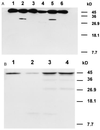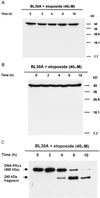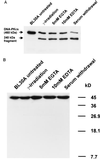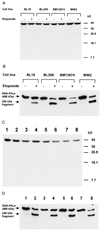Resistance of actin to cleavage during apoptosis
- PMID: 8990178
- PMCID: PMC19266
- DOI: 10.1073/pnas.94.1.157
Resistance of actin to cleavage during apoptosis
Abstract
A small number of cellular proteins present in the nucleus, cytosol, and membrane fraction are specifically cleaved by the interleukin-1beta-converting enzyme (ICE)-like family of proteases during apoptosis. Previous results have demonstrated that one of these, the cytoskeletal protein actin, is degraded in rat PC12 pheochromocytoma cells upon serum withdrawal. Extracts from etoposide-treated U937 cells are also capable of cleaving actin. It was assumed that cleavage of actin represented a general phenomenon, and a mechanism coordinating proteolytic, endonucleolytic, and morphological aspects of apoptosis was proposed. We demonstrate here that actin is resistant to degradation in several different human cells induced to undergo apoptosis in response to a variety of stimuli, including Fas ligation, serum withdrawal, cytotoxic T-cell killing, and DNA damage. On the other hand, cell-free extracts from these cells and the ICE-like protease CPP32 were capable of cleaving actin in vitro. We conclude that while actin contains cleavage sites for ICE-like proteases, it is not degraded in vivo in human cells either because of lack of access of these proteases to actin or due to the presence of other factors that prevent degradation.
Figures




Similar articles
-
Actin cleavage by CPP-32/apopain during the development of apoptosis.Oncogene. 1997 Mar 6;14(9):1007-12. doi: 10.1038/sj.onc.1200919. Oncogene. 1997. PMID: 9070648
-
The cytotoxic cell protease granzyme B initiates apoptosis in a cell-free system by proteolytic processing and activation of the ICE/CED-3 family protease, CPP32, via a novel two-step mechanism.EMBO J. 1996 May 15;15(10):2407-16. EMBO J. 1996. PMID: 8665848 Free PMC article.
-
Interleukin-1 beta-converting enzyme-like protease cleaves DNA-dependent protein kinase in cytotoxic T cell killing.J Exp Med. 1996 Aug 1;184(2):619-26. doi: 10.1084/jem.184.2.619. J Exp Med. 1996. PMID: 8760815 Free PMC article.
-
Cytotoxic lymphocyte killing enters the ice age.Adv Exp Med Biol. 1996;406:29-37. doi: 10.1007/978-1-4899-0274-0_4. Adv Exp Med Biol. 1996. PMID: 8910669 Review. No abstract available.
-
Proteases and cell-mediated cytotoxicity.Crit Rev Immunol. 1998;18(3):255-73. doi: 10.1615/critrevimmunol.v18.i3.50. Crit Rev Immunol. 1998. PMID: 9637413 Review.
Cited by
-
Apoptotic membrane blebbing is regulated by myosin light chain phosphorylation.J Cell Biol. 1998 Feb 9;140(3):627-36. doi: 10.1083/jcb.140.3.627. J Cell Biol. 1998. PMID: 9456322 Free PMC article.
-
Detection of actin cleavage in Alzheimer's disease.Am J Pathol. 1998 Feb;152(2):329-32. Am J Pathol. 1998. PMID: 9466556 Free PMC article. Review. No abstract available.
-
Dictyostelium cell death: early emergence and demise of highly polarized paddle cells.J Cell Biol. 2003 Mar 31;160(7):1105-14. doi: 10.1083/jcb.200212104. Epub 2003 Mar 24. J Cell Biol. 2003. PMID: 12654899 Free PMC article.
-
Dismantling cell-cell contacts during apoptosis is coupled to a caspase-dependent proteolytic cleavage of beta-catenin.J Cell Biol. 1997 Nov 3;139(3):759-71. doi: 10.1083/jcb.139.3.759. J Cell Biol. 1997. PMID: 9348292 Free PMC article.
-
Induction of caspase-3-like protease may mediate delayed neuronal death in the hippocampus after transient cerebral ischemia.J Neurosci. 1998 Jul 1;18(13):4914-28. doi: 10.1523/JNEUROSCI.18-13-04914.1998. J Neurosci. 1998. PMID: 9634557 Free PMC article.
References
Publication types
MeSH terms
Substances
LinkOut - more resources
Full Text Sources
Other Literature Sources
Research Materials
Miscellaneous

